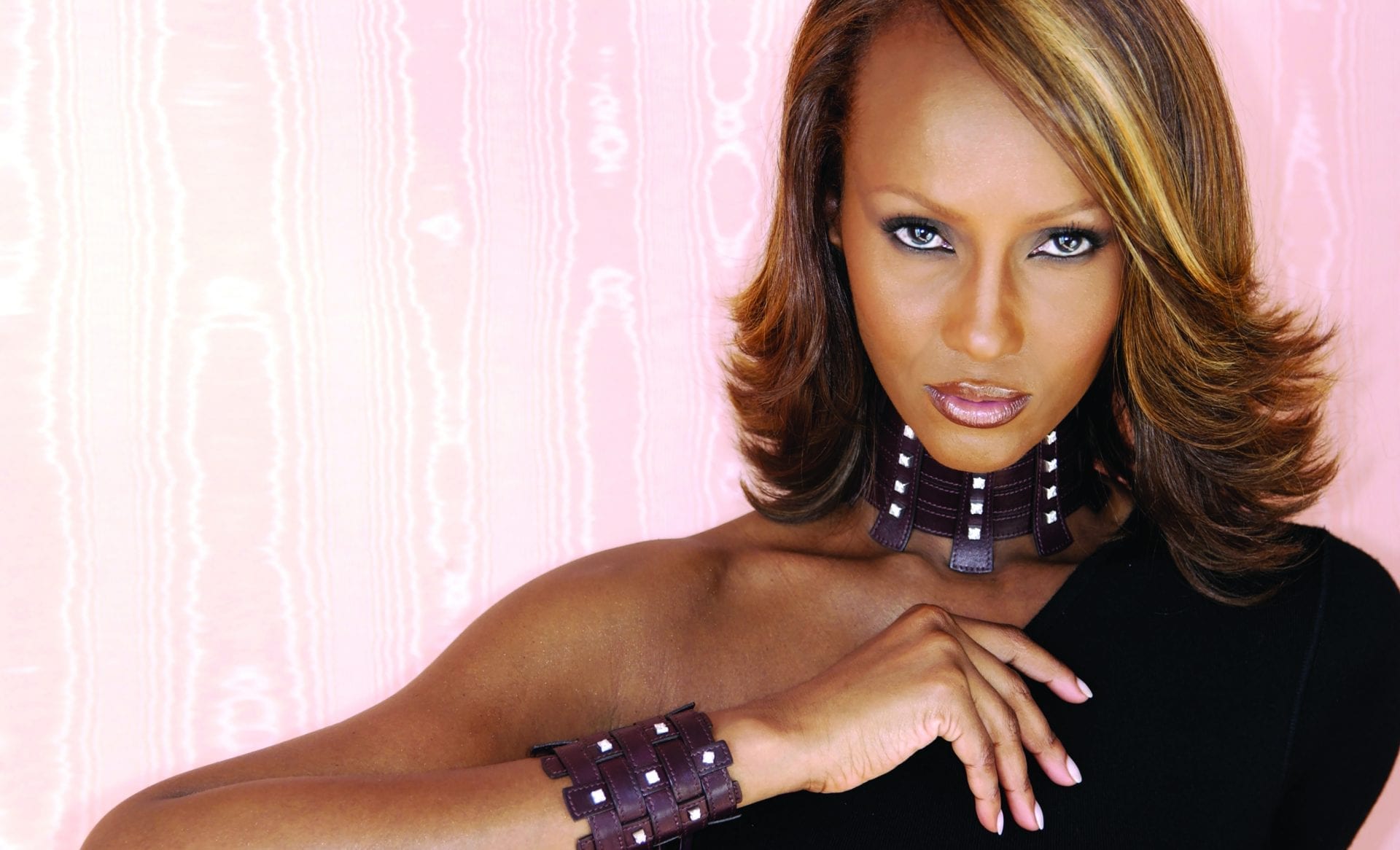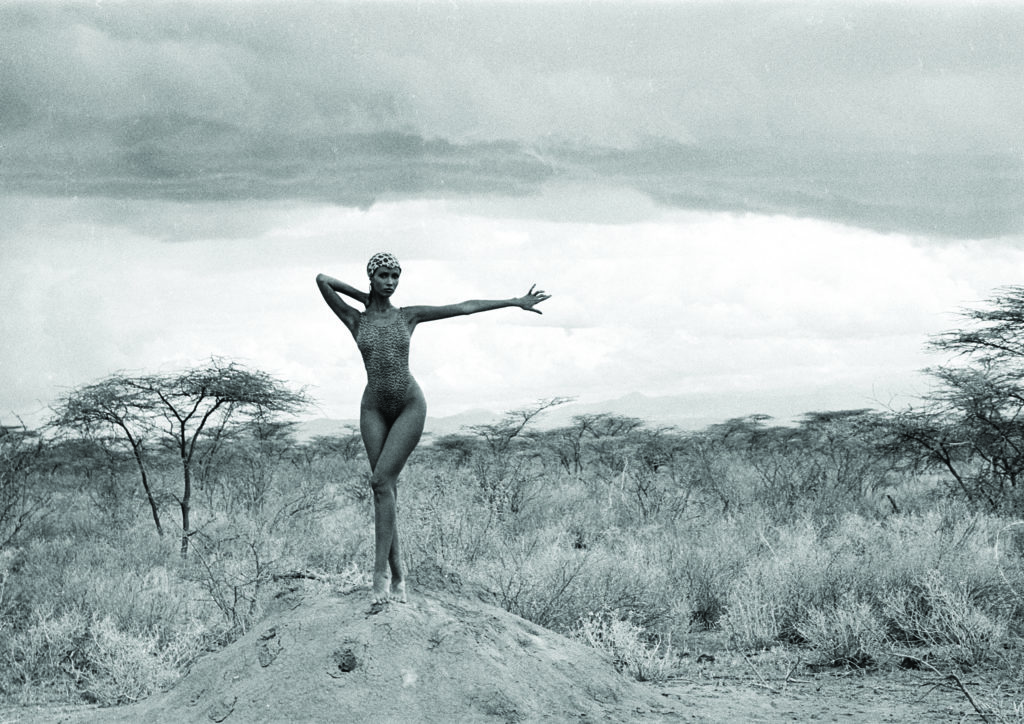There are few mononymous women in the world. Yet one statuesque fashion muse, legendary model, cosmetics entrepreneur and humanitarian stands heads above.
By Christine Morrison
Born Zara Mohamed Abdulmajid, Iman—whose name translates from Arabic as “Faith”—was anointed this traditionally masculine moniker by her mother and grandfather, who wanted her to know she could do anything—and be anything—she envisioned for herself. In a 2014 interview with the Guardian, Iman said, “She always said to me that there is nothing that the boys can do – because I had two brothers – that you can’t do, if not better.”
A proud Somalian, Iman had a privileged childhood with a diplomat father and gynecologist mother, both of whom (like many in the country) valued education. Yet, her formative years were not without crisis. While in boarding school in Egypt, apart from her family residing in Saudi Arabia where her father was ambassador, the 1969 coup in Somalia arose. She reunited with her family, but they were forced to flee to Kenya with just the clothes on their backs.
“Overnight my life changed from a diplomatic daughter to a refugee, and my father could not fend for us,” Iman told the Guardian. “The only time I’ve ever seen my father cry is when he couldn’t pay for us to finish our education . . . The NGOs [non-government organizations] looked after us. They found me a hostel, a job, a university.”
It was there, while strutting toward a political science degree at the University of Nairobi, that she was discovered by famed photographer and Africophile Peter Beard. Iman had a part-time job with the Ministry of Tourism, thanks to her ability to speak five languages, but she lacked funds for future semesters. When Beard offered to pay her for photographs, she requested $8,000, which was the exact price of tuition the following year. Her mother’s mantra—“always know your worth”—echoed in her head. The offer was accepted…
and Africophile Peter Beard. Iman had a parttime job with the Ministry of Tourism, thanks to her ability to speak five languages, but she lacked funds for future semesters. When Beard offered to pay her for photographs, she requested $8,000, which was the exact price of tuition the following year. Her mother’s mantra—“always know your worth”—echoed in her head. The offer was accepted.
Despite becoming an overnight success upon arrival in the U.S., it took months of persuassion by Beard and being signed by Wilhelmina modeling agency for Iman to leave Somalia for good.
On her third day in America, in 1976, Iman landed a shoot for Vogue. Having never worn makeup (or heels for that matter), the shoot was fraught with firsts, including an infamous episode of the makeup artist asking if she’d brought her own foundation. Because black models infrequently graced the magazine’s pages, he was without suitable shades and attempted to blend several to find a complementary color. When Iman saw the images, she felt her skin tone appeared “greige.”
“From the second that picture came out,” she told an interviewer in 2011, “I would find products suitable to my skin. If I am going to stay in this business—or even make it in this business—I have to be my own brand.”
Ever studious by nature, Iman immediately launched into learning “the art of foundation” before founding IMAN Cosmetics in 1994. Having retired from 14 years of modeling, she was dedicated to her business.
“If I needed it and couldn’t find it in the marketplace, surely there are others who need it and can’t find it because it doesn’t exist,” she told Black Enterprise magazine. Instant success—$20 million in domestic sales—reinforced the value of her undertaking. IMAN Cosmetics expanded to the United Kingdom, Canada and France, selling an additional $10 million just three years later. Since that time, the brand has expanded to Brazil, Africa and the Caribbean.
But, Iman held her ground from the start, ignoring retailers who told her that black women don’t buy liquid foundation. IMAN Cosmetics has become much more than a makeup brand— it serves as the premier cosmetics and skincare collection designed for all “Women with Skin of Color,” as the branding states. From primer to lipstick, IMAN Costmetics offers the most variety of makeup for black women.
Iman has stayed consistently at the helm; even today, she thrives on going to the office several days each week. Her cosmetics business evolved from its original QVC and JC Penney distribution to an ambitious partnership with Proctor & Gamble in 2004. Iman was driven to reach the mass market while also fulfilling the void of African-American and multicultural makeup. She also longed to partner with like-minded visionaries.
Iman set about to create a line of cosmetics and skincare products that would meet black women’s needs. Her cutting-edge concept included SPF factor, generally overlooked by major brands that failed to recognize the need for sun protection among black women.
Expansion to the mass market was particularly challenging, despite IMAN Cosmetic’s proven track record. Stores displaced the brand from the cosmetics department into an “ethnic section,” often in the back of the store. Fueled by her fury, Iman became an outspoken advocate, standing up for the women she felt are “marginalized in the beauty aisle.” Speaking to Women’s Wear Daily in 2012, she reminded Walgreens and Target, among others, that “ethnic beauty can’t be confined to part of a cosmetics wall that changes infrequently, nor confined to a handful of doors in urban areas.”
Her business continues to excel despite increased competition. In 2005, Iman capitalized on her cosmetics expertise, authoring the first beauty and make-up book to address the spectrum of skin tones and ethnicities. “The Beauty of Color: The Ultimate Beauty Guide for Skin of Color” represented her company’s vision. “When I started in beauty, the general market usually talked about the girl next door, which meant blonde hair, blue eyes,” she said in a 2006 interview. “But the neighborhoods have changed now. I wanted to celebrate the new generation of women with skin of color that has now become the norm.”
While Iman is proud of her legacy as a cosmetics entrepreneur, it is her humanitarian work that is most inspirational. “I’ve always believed in a life of service,” she said in a 2013 interview with Look TV. “Being a Somali and a Muslim, charity was part and parcel of how you lived. It’s not just about you.”
After her 1992 honeymoon with David Bowie, Iman returned to Somalia for the first time. With a BBC crew in tow, she filmed shocking footage—poverty, hunger and an infinite number of orphans—“to give pain a face.” In addition to the BBC footage, Iman penned an essay for Vogue detailing the horrors. Accompanied by images of her standing alongside children in Baidoa (a city in south-central Somalia where she vacationed as a child and reconnected with her Uncle Ibrahim), she concluded the piece by listing places seeking donations. Despite the fact that efforts had nearly stalled by that time, her dedication was unwavering.
“I always say charity begins at home, so don’t think [it has to be] something very far away from where you are; it could be something happening in your back yard,” she told Look TV.
To this day, Iman continues to focus on the suffering in Somalia in her role as ambassador for the charity Save The Children.
Iman encountered another watershed moment while pregnant with her daughter— she read a New York Times article about women in South Africa transmitting AIDS through breastfeeding. Given both the maternal and financial need to breastfeed in third world countries, she was heartbroken and felt compelled to help immediately. She stepped up as Global Ambassador for “Keep a Child Alive.”
“They are like the punk rock of charities,” she said in the Look TV video. “They are small, they are effective charity is small and effective,” providing healthcare, housing and other support to HIV/AIDS-affected communities in Africa and India.
Iman’s more recent passion has been supporting Dr. Hawa Abdi, who has been called “Equal parts Mother Teresa and Rambo.” As the leader of one of Somalia’s first NGOs, Dr. Hawa Abdi created Hope Village, which has provided free food, healthcare, education, skills training and hope to more than 100,000 people. Iman’s participation with this 2012 Nobel Peace Prize winner – who also provides health care, training for nurses and midwives, and education for women and children – is instrumental in saving lives of malnourished children and working to end sexual and gender-based violence.
Bringing an end to domestic violence closer to home has been on Iman’s agenda as well. In 1998, she created the “Misdemeanor Lipstick” with fellow philanthropist Missy (aka Misdemeanor) Elliott to fund “Break the Cycle,” a prevention and intervention organization for young people to build healthy relationships and create a culture without abuse.
In 2011, Iman was awarded the BET Service Award for her “Raise Hope for Congo Campaign.” The effort was an enormous undertaking, educating activists and the public about the conflict in eastern Congo and the effects of sexual violence as a weapon of war used against Congolese women and girls.
Women’s rights have been pivotal to Iman, particularly championing diversity and equality in her profession, which she has called “a very racist business.”
“Some casting agents had the audacity to say, ‘We’re not seeing black models this season.’ As if black is a trend,” she told Harper’s BAAZAR in 2018.
To raise awareness of this injustice, Iman— joined by her best friend of 40 years, former model agent Bethann Hardison, and model Naomi Campbell—created a campaign in 2013. Coining themselves “The Diversity Coalition,” they engaged the press and the Council of Fashion Designers of America (CFDA) to demand a change on the runways and in campaigns. Iman specifically boycotts buying from any designer who does not use black models. “We should celebrate and highlight the people who actually step it up,” she said.
As a self-described workaholic, Iman has also expanded her brand into the fashion world. In 2007, she was approached by famed HSN executive Mindy Grossman to design a line of apparel. In traditional Iman style, she had an alternative idea—exotic, embroidered and one-size-fits-all caftans to mimic those she had in Egypt. Due to its instant success, Iman’s Global Chic Collection expanded and now offers apparel, accessories and beauty. She is a top seller on the network. Throughout her career, Iman explored film projects and has appeared as a host on multiple fashion television series, from Project Runway in Canada to The Fashion Show: The Ultimate Collection. She was named CFDA’s Fashion Icon in 2010.


